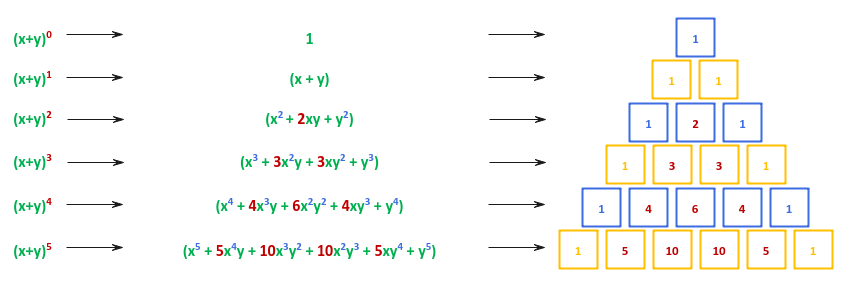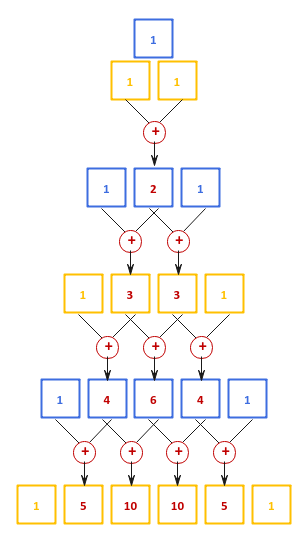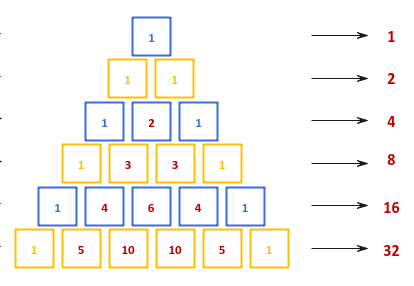
| PolarSPARC |
Binomial Theorem Unravelled
| Bhaskar S | 11/23/2022 |
Binomial Theorem
In the article, Introduction to Permutations & Combinations, we covered the fundamentals of Combinations, which is an essential ingredient for Binomial Theorem.
In high-school algebra, one of the topics covered under Polynomials is the expansion of an equation that involves the summation of two variables (hence the term Binomial).
In particular, the algebriac expansion of the binomial equation $(x + y)^n$, where $n$ is a positive integer.
For example, we know:
$(x + y)^2 = x^2 + 2xy + y^2$ ..... $\color{red} (1)$
Similarly, we also know:
$(x + y)^3 = x^3 + 3x^2y + 3xy^2 + y^3$ ..... $\color{red} (2)$
Observe the expanded equations $\color{red} (1)$ and $\color{red} (2)$ from above more closely and we see the following INTERESTING patterns emerge:
First, the sum of exponents of the two variables for all the terms in the expanded equation add up to the raised power. In other words, consider binomial equation $(x + y)^3$, which is rasied to the power of $3$. The sum of exponents of each terms is equal to $3$. The exponents of $x^3$ and $y^3$ are both equal to $3$. Similarly, the sum of the exponents of $x^2y$ and $xy^2$ are also equal to $3$.
Second, the number of expanded terms is ONE MORE than the raised exponent power. In other words, for the binomial equation $(x + y)^2$ that is raised to the power of $2$, the expanded equation has $3$ terms. Similarly, for the binomial equation $(x + y)^3$ which is raised to the power of $3$, the expanded equation has $4$ terms.
Third, the exponent of first variable $x$ decreases from the raised exponent power to zero, while the exponent of second variable $y$ increases from zero to the raised exponent power.
One may be wondering about the coefficients of each of the terms in the expanded algebriac equation for a given raised exponent power. Interestingly, the coefficients also follow a pattern, which will not be obvious from the expanded equation.
This is where the Pascal's Triangle comes into play.
The following illustration shows the Pascal's Triangle for the raised exponent powers of 0 through 5:

The Pascal's Triangle in Fig.1 above shows the coefficients of each term in the expanded binomial equation for a given exponent power. The coefficients in each row of the Pascal's Triangle builds from the coefficients of the previous row.
The following illustration shows the relationship between a row and the previous row of the Pascal's Triangle:

Another interesting observation from the Pascal's Triangle is that the sum of coefficients in each row is a value that is the exponent power of $2$.
The following illustration shows each row and its corresponding exponent power of $2$ for the Pascal's Triangle:

Another INTERESTING fact about the coefficients in the Pascal's Triangle - they are related to combinations.
The following illustration shows how each row of coefficients and its relationship to combinations:

Recollect that the combination of choosing $k$ items from $n$ items is given as $_nC_k = \Large{\frac{n!}{k! (n-k)!}}$.
Therefore, $_2C_0 = \Large{\frac{2!}{0! 2!}}$ $= 1$, $_2C_1 = \Large{\frac{2!}{1! 1!}}$ $= 2$, $_2C_2 = \Large{\frac{2!}{2! 0!}}$ $= 1$, and so on.
The binomial equation for any exponent power $n$ can be generalized as follows:
$\bbox[pink,2pt] {(x + y)^n = {_nC_0.x^n.y^0} + {_nC_1.x^{n-1}.y^1} + {_nC_2.x^{n-2}.y^2} + ... + {_nC_{n-1}.x^1.y^{n-1}} + {_nC_n.x^0.y^n} = \sum_{k=0}^n {_nC_k} . x^{n-k} . y^k}$ ..... $\color{red} (3)$
From the equation $\color{red} (3)$ from above, we can infer that the term ${_nC_0.x^n.y^0}$ is the first, the term ${_nC_1.x^{n-1}.y^1}$ is the second, the term ${_nC_2.x^{n-2}.y^2}$ is the third and so on.
Hence, one can generalize the $k^{th}$ term as follows:
$\bbox[pink,2pt] {_nC_{k-1}.x^{n-k+1}.y^{k-1}}$
Solved Problems
| Example-1 | Expand the binomial expression $(2x - y^2)^4$ |
|---|---|
|
Let $A = 2x$ and $B = -y^2$ Then, we know the following: $(A + B)^4 = A^4 + 4A^3B + 6A^2B^2 + 4AB^3 + B^4$ That is: $(2x)^4 + 4(2x)^3(-y^2) + 6(2x)^2(-y^2)^2 + 4(2x)(-y^2)^3 + (-y^2)^4$ Therefore $(2x - y^2)^4 = 16x^4 -32x^3y^2 + 24x^2y^4 - 8xy^6 + y^8$ |
|
| Example-2 | Find the $3^{rd}$ term of the binomial equation $(3x + 5y)^8$ |
|---|---|
|
Let $A = 3x$ and $B = 5y$ Then, we know the $k^{th}$ term is as follows: $_nC_{k-1}.A^{n-k+1}.B^{k-1}$ That is: $_8C_2.A^6.B^2 = 28.(3x)^6.(5y)^2$ Therefore, the $3^{rd}$ term is $510300.x^6.y^2$ |
|
References